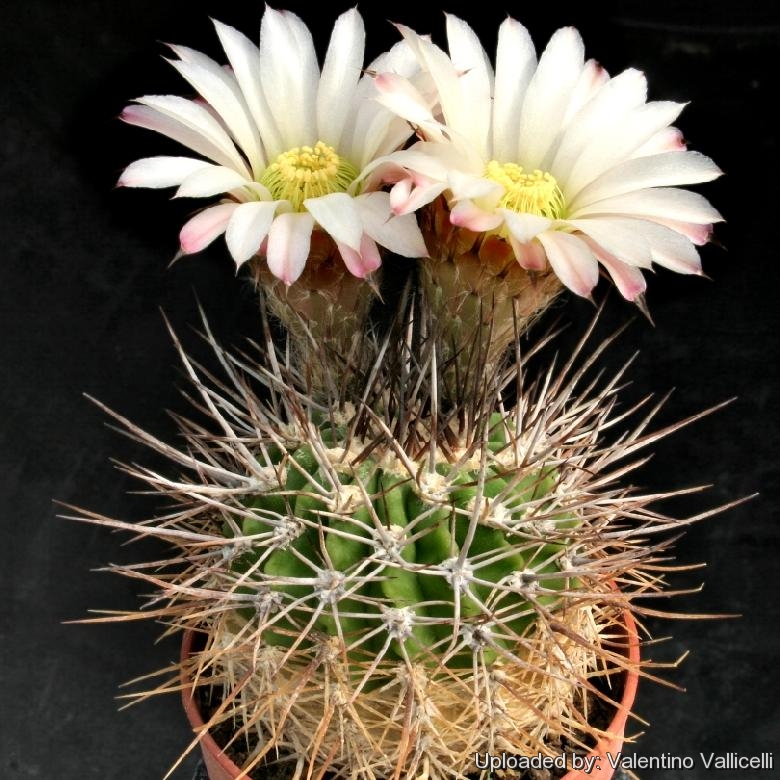
Acanthocalycium spiniflorum Photo by: Valentino Vallicelli
Origin and Habitat: Argentina (Catamarca, Córdoba, La Rioja, San Luis, Santiago del Estero). The species has a wide range and is locally abundant.
Altitude range: (450-)1,000 to 1,500(-2,400) metres above sea level.
Habitat and ecology: The species grows in monte shrubland and chaco, always associated to mountainous soils in areas that have periods of cold in winter. There are no known major threats for this species. There is no known use or trade for this cactus.
Synonyms:
See all synonyms of Acanthocalycium spiniflorum
back
Accepted name in llifle Database:Acanthocalycium spiniflorum (K.Schum.) Backeb. in Backeb. & F.M.KnuthDescr. Cact. Nov. 226. 1936 [12 Feb 1936]Synonymy: 8
back
Common Names include:
RUSSIAN (Русский): Акантокалициум колючецветковый
Description: Acanthocalycium spiniflorumSN|74]]SN|74]] (Echinopsis spinifloraSN|72]]SN|72]]) is usually solitary or slowly branching through basal shoots, it can become an upright cactus with stems that can reach a height of about 15 cm. The spines are arranged neatly in rows down the stem. The showy flowers range from white to pinkish lilac and are about 4 cm across. It is a pretty variable species.
Derivation of specific name: Acanthocalycium spiniflorum - both the genus and species names refer to the characteristic spiny flower tube.
Stem: Usually single spherical, depressed apically, in time becomes slightly cylindrical, growing in habitat to a height of 12-15 cm, and a diameter of 6 to 10 cm, but can reach a height of almost 60 cm and be over 15 cm in diameter in a heated greenhouse or outdoors where winters are warm. The epidermis is pale to dark green.
Ribs: About 16-20, acute, somewhat tuberculate, to10 mm high.
Areoles: At the apex of tubercles, 1.5-2 cm apart, at first covered with yellowish-brown felt. The lower part of the areola is elongated while the upper part curves around the sides of the rib, more or less in the shape of a small shield. As the tubercles widen in the course of growth, the areoles become elliptical and almost glabrous.
Spines: 10-20, straight, needle-like, flexible, yellowish to brown, with dark tips, becoming grey with age all more or less of the same length in a given plant (0,5-4 cm), but this species appears to be very variable about the length colour and number of spines in different population. They usually are black or light brown at first, becoming grey or whitish-yellow as they ages.
Flowers: Bell-shaped to funnelform, erect, 4-5 cm long, 4 cm in diameter, on lateral areoles close to the stem apex, and the segments of the perianth are pale mauve, pink or white. Pericarpel and floral tube green, with dense, narrow, spine-tipped brownish scales approximatively 1 cm long , sparsely hairy in their axils. Stamens in several rows, incurred, with no separate throat-circle. Stigmas 6 mm long, pale green. Flower-buds very hairy.
Fruit: Globose, about 1 cm in diameter, firm, with persistent scales, splitting vertically when ripe.
Seeds: Ovoidal, brown to black.
Chromosome number: 2n = 22
Subspecies, varieties, forms and cultivars of plants belonging to the Acanthocalycium Spiniflorum group
 Acanthocalycium spiniflorum (K.Schum.) Backeb. in Backeb. & F.M.Knuth: up to 60 cm tall and 15 cm thick. Spines yellowish to brown, with dark tips. Flowers white to lilac. Distribution: Argentina (Catamarca, Córdoba, La Rioja, San Luis, Santiago del Estero)
Acanthocalycium spiniflorum (K.Schum.) Backeb. in Backeb. & F.M.Knuth: up to 60 cm tall and 15 cm thick. Spines yellowish to brown, with dark tips. Flowers white to lilac. Distribution: Argentina (Catamarca, Córdoba, La Rioja, San Luis, Santiago del Estero) Acanthocalycium spiniflorum f. violaceum (Werderm.) Donald: has pale-lilac flowers and ribbed body armed with yellow or honey-coloured, spines. Distribution: Córdoba, Argentina.
Acanthocalycium spiniflorum f. violaceum (Werderm.) Donald: has pale-lilac flowers and ribbed body armed with yellow or honey-coloured, spines. Distribution: Córdoba, Argentina.
Notes: The feature distinguishing Acanthocalycium from its relatives is the spiny bud which gives it its name.
Bibliography: Major references and further lectures
1) David R Hunt; Nigel P Taylor; Graham Charles; International Cactaceae Systematics Group. “The New Cactus Lexicon.” dh Books, Milborne Port, UK. 2006.
2) Edward Anderson “The Cactus family” Timber Press, Incorporated, 2001
3) James Cullen, Sabina G. Knees, H. Suzanne Cubey "The European Garden Flora Flowering Plants: A Manual for the Identification of Plants Cultivated in Europe, Both Out-of-Doors and Under Glass" Cambridge University Press, 11/Aug/2011
4) Demaio, P., Perea, M. & Trevisson, M. 2013. Echinopsis spiniflora. The IUCN Red List of Threatened Species 2013: e.T152026A588662. http://dx.doi.org/10.2305/IUCN.UK.2013-1.RLTS.T152026A588662.en. Downloaded on 08 February 2016.
5) Leo J. Chance “Cacti and Succulents for Cold Climates: 274 Outstanding Species for Challenging Conditions” Timber Press, 19 June 2012
6) Hecht, “BLV Handbuch der Kakteen” 1982
7) Haustein, “Der Kosmos-Kakteenftihrer” 1983
8) Keith Grantham, Paul Klaassen “The plantfinder's guide to cacti & other succulents” Timber Press, 18 May 1999
9) M.L. Las Peñas, J.D. Urdampilleta, G. Bernardello, E.R. Forni-Martins “Karyotypes, heterochromatin, and physical mapping of 18S-26S rDNA in Cactaceae” Cytogenet Genome Res 2009;124:72–80
10) Bill Keen “CACTI AND SUCCULENTS: Step-by-Step to Growing Success” Crowood, 18 October 201
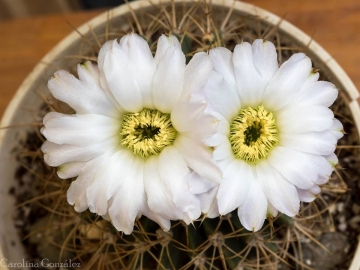 Acanthocalycium spiniflorum Photo by: Carolina González
Acanthocalycium spiniflorum Photo by: Carolina González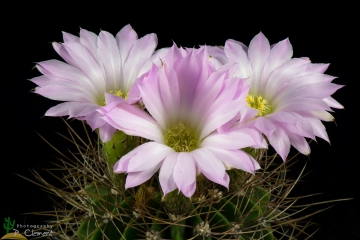 Acanthocalycium spiniflorum Photo by: Peiffer Clement
Acanthocalycium spiniflorum Photo by: Peiffer Clement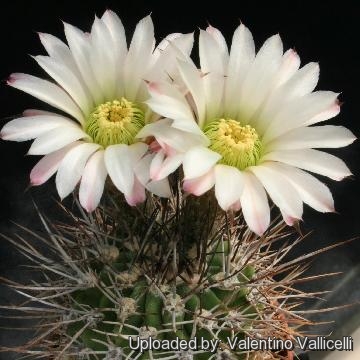 Acanthocalycium spiniflorum Photo by: Valentino Vallicelli
Acanthocalycium spiniflorum Photo by: Valentino Vallicelli Acanthocalycium spiniflorum Photo by: Valentino Vallicelli
Acanthocalycium spiniflorum Photo by: Valentino Vallicelli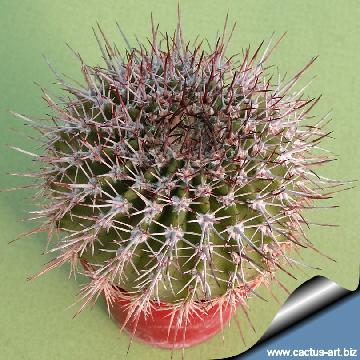 Acanthocalycium spiniflorum Photo by: Cactus Art
Acanthocalycium spiniflorum Photo by: Cactus Art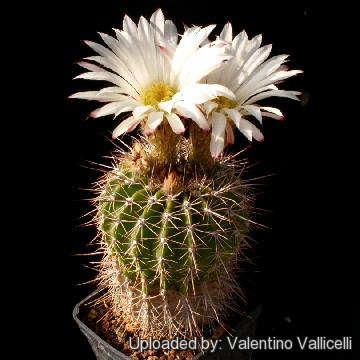 Acanthocalycium spiniflorum Photo by: Valentino Vallicelli
Acanthocalycium spiniflorum Photo by: Valentino VallicelliCultivation and Propagation: Acanthocalycium spiniflorumSN|74]]SN|74]] is an easy to grow succulent, more cold tolerant than most and less fussy regarding soil conditions.
Growth rate: It is a relatively rapidly growing and easily flowering species. The larger these plants are when they placed in the garden, the more likely they are to survive. They are much more vigorous in the garden if they are not allowed to remain dry for long periods during the growing season.
Soils: It likes very porous standard cactus mix soil.
Repotting: Use pot with good drainage.
Watering: Water regularly in summer, but do not overwater (Rot prone), keep dry in winter.
Fertilization: Feed with a high potassium fertilizer in summer.
Hardiness: Reputedly somewhat resistant to frost if kept on the dry side prior to, and during, cold weather (hardy to -12 C ° C, or less for short periods).
Exposition: Outside bright sunlight or afternoon shade, inside it needs bright light, and some direct sun, full sun is indispensable to keep plant compact with strong spines.
Uses: It is an excellent plant for container growing. It always looks good and stays small. It look fine in a cold greenhouse and frame or outdoor in a rockery.
Pests & diseases: It may be attractive to a variety of insects, but plants in good condition should be nearly pest-free, particularly if they are grown in a mineral potting-mix, with good exposure and ventilation. Nonetheless, there are several pests to watch for:
- Red spiders: Sensitive to red spider mite. Overhead watering is helpful in controlling mites.
- Mealy bugs: Occasionally mealy bugs they develop aerial into the new growth among the wool with disfiguring results, but the worst types develop underground on the roots and are invisible except by their effects.
- Scales: Scales are rarely a problem.
- Rot: Rot is only a minor problem with cacti if the plants are watered and “aired” correctly. If they are not, fungicides won't help all that much.
Propagation: Direct sow after last frost. Seeds germinate in 7-14 days at 21-27° C in spring, remove gradually the glass cover as soon the plants will be well rooted (ca 1-2 weeks) and keep ventilated, no full sun for young plants!

















